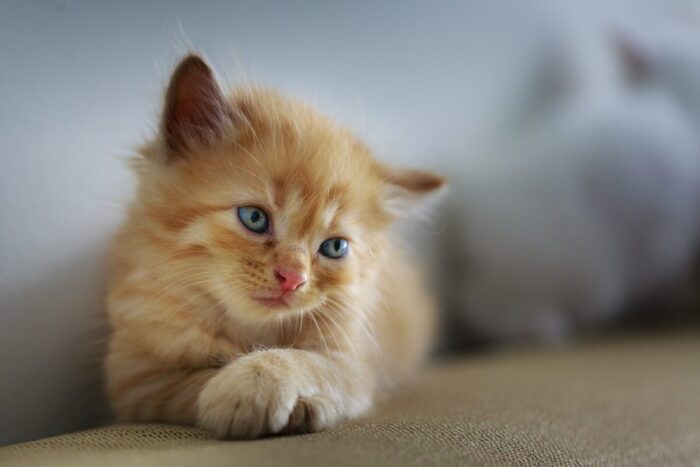Have you ever walked into your home to be greeted by a pungent, unmistakable odor? You know that smell – it’s the lingering scent of cat urine, and it’s a sign that your feline friend is marking their territory in an undesirable place. While frustrating, it’s important to remember that cats don’t pee outside the litter box out of spite. Instead, they’re often signaling a need, a distress, or even a medical issue. This article will guide you through the most common reasons for this behavior and equip you with the tools and knowledge to help your cat overcome it.

Image: pethelpful.com
Understanding why your cat is peeing outside the litter box is the first step to solving the problem. Whether it’s a change in environment, a medical condition, or a simple aversion to the litter box itself, pinpointing the cause is crucial. With patience and understanding, you can work with your cat to establish a healthy and hygienic relationship while ensuring your home stays smelling fresh and welcoming.
Decoding the Message: Why is My Cat Peeing Outside the Litter Box?
1. Medical Reasons:
Before you begin rearranging furniture and experimenting with different litter types, it’s essential to rule out any underlying medical condition. Cats, just like humans, can experience urinary tract infections (UTIs), bladder stones, or other illnesses that can lead to accidents. If your cat is suddenly exhibiting this behavior, an immediate visit to the veterinarian is crucial for a proper diagnosis and treatment. A vet can test your cat’s urine, examine their bladder, and provide appropriate medication if needed.
2. Litter Box Aversions:
Cats are creatures of habit and are known for their discerning preferences. It’s crucial to consider your cat’s unique litter box needs. Some cats may dislike the type of litter, the location of the box, or even the cleanliness level. Experiment with different types of litter, finding one that’s appealing to your cat. Try clumping or non-clumping varieties, natural or artificial litters, or even paper-based litters. Ensure the litter box is in a quiet and accessible location, away from high-traffic areas or loud noises.
Keep the box clean and scoop it regularly, ideally multiple times a day. A clogged litter box can signal to your cat that it’s not a viable option, leading them to seek out other places to relieve themselves.

Image: kittyexpert.com
3. Environmental Changes:
Cats are creatures of routine, and abrupt changes to their environment can lead to anxiety and stress, which can manifest in inappropriate urination. If your home has experienced recent renovations, a new pet has joined the family, or a family member has moved out, these changes might be the root cause of your cat’s behavior. Allow your cat time to adapt to their new environment. Consider using calming pheromone sprays or diffusers to create a sense of security and comfort.
4. Territorial Marking:
Cats naturally mark their territory through scent, and they might be spraying urine on vertical surfaces like walls, furniture, or doorways to establish dominance or alleviate stress. This behavior is more common in intact male cats, but even neutered or spayed cats can exhibit this behavior. Consider using a catnip spray or pheromone spray to discourage them from marking.
Solutions for Cat Urine Accidents:
Now that you’ve identified the potential causes, it’s time to implement solutions. Here is a comprehensive approach to addressing your cat’s inappropriate urination:
1. Deep Clean:
The smell of urine can trigger your cat to repeat the behavior. Cleaning the affected areas thoroughly is crucial. Traditional cleaners often mask the scent but don’t eliminate it completely. Use an enzyme-based cleaner specifically designed for pet urine, as these cleaners break down the urine molecules and neutralize the odor, preventing your cat from identifying those spots as desirable “toilets.”
2. Litter Box Placement:
Ensure your cat has easy access to the litter box at all times. Consider having multiple litter boxes in different locations, especially if you have multiple cats. Place the boxes away from food and water bowls, as well as noisy appliances or high-traffic areas.
3. Litter Box Maintenance:
Scooping your cat’s litter box frequently is crucial. Ideally, scoop it at least twice a day, but more often if necessary. Cats are sensitive to cleanliness and won’t use a dirty litter box. Wash the litter box with hot soapy water and let it dry completely before adding fresh litter.
4. Positive Reinforcement:
When your cat uses the litter box appropriately, reward them with praise, treats, or a favorite toy. This positive reinforcement helps associate the litter box with pleasurable experiences, making it a more attractive option for future urination.
5. Professional Help:
If you’ve tried all the above strategies and your cat continues to have accidents, consider consulting a veterinarian or a certified animal behaviorist. They can assess your cat’s individual needs and provide personalized guidance, possibly involving medication or behavior modification therapy.
Prevention is Key:
By addressing the root cause of your cat’s inappropriate urination and following the strategies mentioned above, you can effectively prevent future accidents and restore harmony to your home. Remember, patience and consistency are key. Don’t punish your cat for accidents, as this will only worsen the situation.
How To Get Cat To Stop Peeing On Floor
https://youtube.com/watch?v=pAuA1nRb7g0
Conclusion:
Addressing your cat’s inappropriate urination involves understanding the underlying reasons, implementing effective cleaning and preventative measures, and ensuring the litter box environment is appealing and accessible. With a patient and empathetic approach, you can re-establish healthy habits for your cat and enjoy a clean and odor-free home. Remember, the key is to work with your cat, not against them, to create a happy and harmonious environment for both of you.





